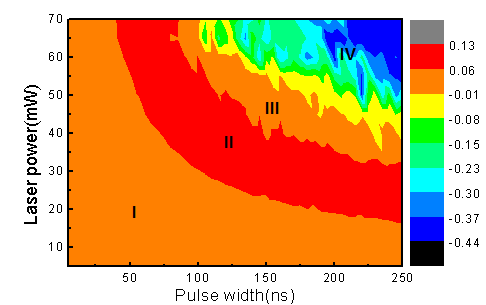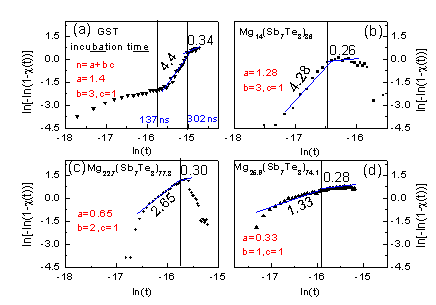
PTE (power-time-effect) diagram ofMg22.7(Sb7Te3)77.3film
Guoxiang Wang*, et al., Ceramics International, 143, 12452-12458 (2017)
Read More:
Generally, suitable materials for electrical or optical storage must satisfy three characteristics: show a rapid change between the amorphous and crystalline phases; feature long-term data retention at high temperatures; possess a large difference in the electrical resistivity or optical reflectivity between the amorphous and crystalline states. Phase change materials should try to achieve a good balance among these three characteristics. In this work, the effects of Mg on the structure and phase-change kinetics of Sb7Te3 were investigated for phase change memory application. The results revealed that the addition of Mg increased the crystallization temperature, and crystalline activation energy, while hindering grain growth and suppressing phase separation from Sb+Sb2Te, Sb2Te, to Sb phases. Laser-induced phase-change behavior showed four regions in the Mg-Sb7Te3 films: crystallization, transition toward stability, amorphization and ablation. A reversible switching between crystallization and amorphization occurred more rapidly in Mg-doped Sb7Te3 films than in conventional Ge2Sb2Te5. Evaluation of Johnson-Mehl-Avrami plots indicated that the crystallization mode changed from three, two to one-dimensional grain growth as the Mg-doping level increased. This phenomenon contributed to the rapid phase change of Mg-doped Sb7Te3 films.

The John-Mehl-Avrami (JMA) plots for the 40 mW laser-induced crystallization of (a) GST, (b) Mg14(Sb7Te3)88, (c) Mg22.7(Sb7Te3)77.3 and (d) Mg26.9(Sb7Te3)74.1 film on the nanosecond time scale.


